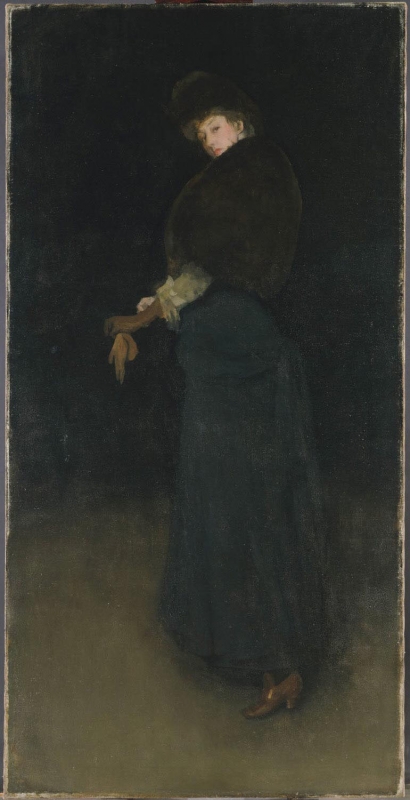Composition
The Pennells quote a letter from the sitter in which she stated, 'I think I sat to him [Whistler] during a year or so, off and on, for a great many studies in different costumes and poses'; she added that, when she returned to London after interrupting sittings for The Grey Lady: Portrait of Lady Archibald Campbell [YMSM 241], Whistler asked to make a study of her 'in the dress in which I called upon him', and that this became Arrangement in Black: La Dame au brodequin jaune - Portrait of Lady Archibald Campbell [YMSM 242]. 1
Duret told the Pennells that 'she suggested changes to Whistler, who, though he seldom accepted suggestions from his sitters, did his best to meet her wishes until it seemed as if, to please her, he must repaint his picture, and he was seized with discouragement.' 2
'Lady Archie’s clothing complements the twisting pose. Her costume forms a series of oppositional curves—from the blue-gray skirt swinging out from the atmospheric background, to the fur cap pointing away from the viewer—while revealing only the broadest outlines of her reportedly svelte figure. ''' ' 3
Technique

Arrangement in Black: La Dame au brodequin jaune – Portrait of Lady Archibald Campbell, Philadelphia Museum of Art
She posed, according to Sickert, against a background of black velvet, in Whistler's Tite Street studio. The Pennells quote the sitter as saying it was 'painted in a very few sittings.' 4 However, as Robins notes, 'everyone who witnessed his painting performance testified that it was an agonising process, with Whistler endlessly rubbing out and repainting the atmospheric depth. The black was never intended to be a black background (once again, Sickert is the authority for this) but a black in front of which was "admirably observed atmosphere" '. 5
It was painted fairly thinly, the shadows merging with the figure, the edges of the figure being mainly soft, painted while the background was wet. Only at the left, down the curve of her torso, is there a more precisely defined edge. Brushstrokes are, however, clearly visible on the hands and sleeve, and a few strokes define her glove. The face is quite highly finished and precise, but the hair is, again, indicated with a few curving sweeps of the brush.
George Moore (1852-1933) commented that 'the fingers of the right hand … are non-existent; after a dozen attempts to paint the gloved hand, only an approximate result was obtained. Look at the ear, and say that the painter's nerves did not give way once or twice. And the likeness is vague and shadowy.' 6
Conservation History
Unknown.
Frame
Portrait Whistler frame, dating from ca 1884 [17.2 cm]. 7
Notes:
1: Pennell 1908 [more] , vol. 1, pp. 305-07.
2: Ibid, vol. 1, p. 306.
3:
4: Pennell 1908 [more] , vol. 1, pp. 305-07.
5: Robins 2007 [more] , pp. 67-68.Sickert 1908 B [more] ; W. Sickert 2000 [more] , p. 185.
6: Moore 1893 [more] , pp. 8-9.
7: Dr Sarah L. Parkerson Day, Report on frames, 2017. See also Parkerson 2007 [more] .
Last updated: 8th June 2021 by Margaret





